CENTER STAGE HOOSIERS TAKE
Civic theaters are a vital cultural resource for communities throughout Indiana

JULY 2025







Civic theaters are a vital cultural resource for communities throughout Indiana

JULY 2025






This month, Indiana Electric Cooperatives (IEC) — the statewide organization that publishes Indiana Connection — is celebrating its 90th anniversary.
On March 9, 1935, Governor Paul V. McNutt signed the Indiana REMC Act into law. The bill, authored by I. Harvey Hull and Frederick Barrows, was the first of its kind in the country, allowing for the formation of rural electric membership cooperatives. The electric power industry would not extend lines to rural areas because they did not find it profitable.
According to “Power to the People,” a book written by former Indiana Connection Editor Emily Schilling, Hull was inspired to create rural co-ops after a trip to Scandinavia in 1933. He was impressed by the high standard of living in the farm communities and their access to electricity. He learned that 65% of rural Norway and Sweden were electrified, which was possible because the consumers owned the electric lines.
Two months after the Indiana law was enacted, President Franklin D. Roosevelt signed legislation establishing the Rural Electrification Administration as a relief agency. This enabled Congress to allocate $1 million for rural electrification projects. As a result, Indiana had the funds needed to create the rural electric co-ops.
The Indiana REMC Act enabled the formation of the Indiana Statewide Rural Electric Membership Corporation, which was officially founded in July 1935 to help develop co-ops throughout the state.
IEC has evolved significantly over the past nine decades. Still, the organization continues its original goal of promoting and supporting Indiana’s electric coops, enabling them to serve their members effectively. Today, IEC assists the co-ops through government relations, safety training and compliance, culture and career development, and communications.
I’m proud to play a small role in helping Indiana’s electric co-ops serve their members. Here’s to 90 more years of continued success.
Britt Davis Editor bdavis@indianaec.org
On the menu: October: Submit your favorite sweet and salty recipes, deadline Aug. 1. If we publish your recipe on our food pages, we’ll send you a $10 gift card.
Giveaway: Enter to win a $30 gift card from Indiana Caverns. Visit indianaconnection.org/talk-to-us/contests or send your contact information to the address below. The deadline to enter is July 31.
Three ways to contact us: To send us recipes, photos, letters and entries for gift drawings, please use the forms on our website indianaconnection.org; email info@indianaconnection.org; or send to Indiana Connection, 11805 Pennsylvania Street, Carmel, IN 46032.
VOLUME 75 • NUMBER 1 ISSN 0745-4651 • USPS 262-340
Published monthly by Indiana Electric Cooperatives
Indiana Connection is for and about members of Indiana’s locally-owned, not-for-profit electric cooperatives. It helps consumers use electricity safely and efficiently; understand energy issues; connect with their co-op; and celebrate life in Indiana. Over 311,000 residents and businesses receive the magazine as part of their electric co-op membership. The average printed and mailed cost per issue is 54 cents.
CONTACT US: 11805 Pennsylvania Street Carmel, IN 46032 317-487-2220
info@indianaconnection.org IndianaConnection.org
INDIANA ELECTRIC COOPERATIVES OFFICERS:
Steve McMichael President Dr. Richard Leeper Vice President
Jamey Marcum Secretary/Treasurer
John Cassady CEO
EDITORIAL STAFF:
Britt Davis Editor
Mandy Barth Vice President of Communication
Lauren Carman Communication Manager
Ashley Curry Production and Design Coordinator
Holly Huffman Communication Support Specialist
Amber Knight Creative Manager
Kiley Lipps Graphic Designer
ADVERTISING:
American MainStreet Publications Cheryl Solomon, local ad representative; 512-441-5200; amp.coop
Paid advertisements are not endorsements by any electric cooperative or this publication.
UNSOLICITED MATERIAL:
Indiana Connection does not use unsolicited freelance manuscripts or photographs and assumes no responsibility for the safekeeping or return of unsolicited material.
SUBSCRIPTIONS: $12 for individuals not subscribing through participating REMCs/RECs.
CHANGE OF ADDRESS:
If you receive Indiana Connection through your electric co-op membership, report address changes to your local co-op.
POSTAGE:
Periodicals postage paid at Indianapolis, Indiana, and at additional mailing offices.
POSTMASTER: Send change of address to: Indiana Connection, 11805 Pennsylvania Street, Carmel, IN 46032. Include key number.
No portion of Indiana Connection may be reproduced without permission of the editor.






www.seiremc.com
CONTACT US 812-689-4111 800-737-4111
Fax: 812-689-6987
Pay by phone: 844-959-3031
EMAIL contact_us@seiremc.com
OFFICE HOURS
7:30 a.m.–4:30 p.m., Monday–Friday
STREET ADDRESS 712 South Buckeye Street Osgood, IN 47037
MAILING ADDRESS
P.O. Box 196 Osgood, IN 47037
SERVICE INTERRUPTIONS
To report a power outage: 800-737-4111 or SmartHub
BOARD OF DIRECTORS
Melissa Menchhofer (District 5), President
Mike Thieman (District 6), Vice President Vince Moster (District 1), Secretary Casey Menchhofer (District 9), Treasurer
Brad Bentle (District 2)
David Smith (District 3)
Jesse McClure (District 4)
Darrell Smith (District 7)
Sherry Shaw (District 8)

CONNECTING AT THE SPEED OF LIGHT NO CONTRACTS. NO DATA CAPS. NO HIDDEN FEES Sign Up Today!
To safely provide reliable electricity and diversified services to the members and communities we serve.
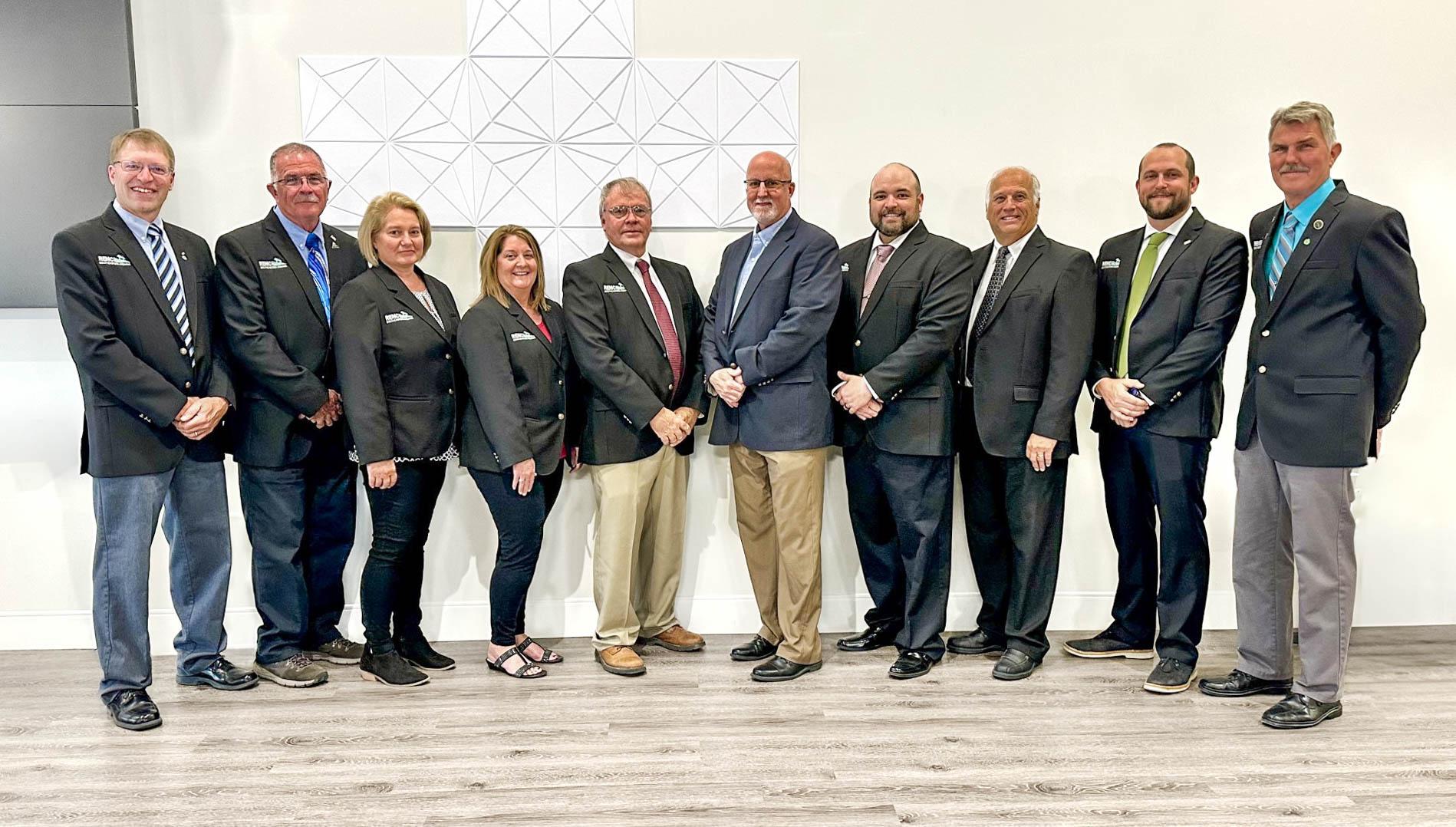
Thank you to all the members who participated in our 2025 Director Election. Member engagement is a cornerstone of our cooperative model and we are grateful to everyone who cast a ballot and took part in shaping the future of Southeastern Indiana REMC.
During our Virtual Annual Meeting, which was held live on Facebook on May 19, we announced that all incumbent directors were re-elected. Jesse McClure will continue to serve District 4, Melissa Menchhofer will represent District 5, and Casey Menchhofer will retain her seat for District 9. This year, a total of 2,596 ballots were cast out of 24,068 eligible members, resulting in a 10.79% voter turnout. We appreciate the members who took the time to vote and help carry on the cooperative tradition of democratic control.
Following the meeting, the Southeastern Indiana REMC Board of Directors held its reorganizational session to elect new officers for the coming term. Melissa Menchhofer was elected president, Mike Thieman was selected as vice president, Casey Menchhofer will serve as treasurer, and Vince Moster was chosen as secretary.
This year marks a historic milestone for SEI REMC. Melissa Menchhofer's election as board president makes her the first woman in our cooperative’s history to hold this leadership role. It is a meaningful step forward and a reflection of the strength and dedication she brings to our organization.
As we celebrate these milestones and transitions, we look ahead with optimism and a renewed sense of purpose. Our board remains committed to responsible governance, community-driven leadership and delivering reliable, innovative service to all members across our cooperative.




SEI Fiber is hitting the fairgrounds this summer and we’re bringing breakfast with us! Stop by our booth at your local 4-H fair and grab a mini box of our signature fiber cereal. Whether you're a casual browser or a serious streamer, there's a "fiber" flavor for everyone.
Fiber Flakes – Simple, satisfying, and reliable just like our Basic package.
Stream Crunch – For those who need a little more speed. Our Plus package keeps the whole household connected.
Fiber MAX – Power-packed for performance. Our Premium package is built for streaming, gaming, and serious multitasking.
Each mini box comes with a fibrous snack inside and information about the SEI Fiber package it represents. Learn more about how we’re keeping Southeastern Indiana connected with speeds and service that are anything but flaky.
Catch us at a fair near you!

Switzerland County: June 28–July 5
Jefferson County: July 7–11
Franklin County: July 14–19
Ripley County: July 20–26
Come say hi, grab a snack, and find your perfect Fiber fit!


Southeastern Indiana REMC is proud to share exciting news: District 3 Director
David Smith has been elected as Chairman of the Hoosier Energy Board of Directors. With this achievement, Smith becomes the first representative from SEI REMC to serve in this top leadership role, marking a significant milestone for our cooperative and its growing influence in the statewide energy network.
Smith has been a steadfast advocate for Southeastern Indiana's rural communities for over 16 years. His extensive knowledge of cooperative principles, combined with a deep understanding of member needs, has positioned him as a respected leader both locally and across the Hoosier Energy system.
"I'm honored to have the opportunity to serve as Chairman of the Hoosier Energy Board," said Smith. "This role is not just about leadership. It's about listening, collaboration, and building a more reliable and affordable energy future for all members."
Hoosier Energy is a generation and transmission cooperative that supplies power to 17 member cooperatives across southern Indiana and southeastern Illinois. Smith’s election reflects the trust his peers have in his ability to lead during a time of innovation and transition in the energy sector.
"We’re not just managing power, we’re preparing for tomorrow," Smith added. "From renewable integration to reliability, I look forward to guiding thoughtful decisions that benefit every cooperative and every member."
Please join SEI REMC in congratulating Smith on this outstanding achievement. His leadership ensures our cooperative’s voice remains strong in shaping the energy landscape for years to come.
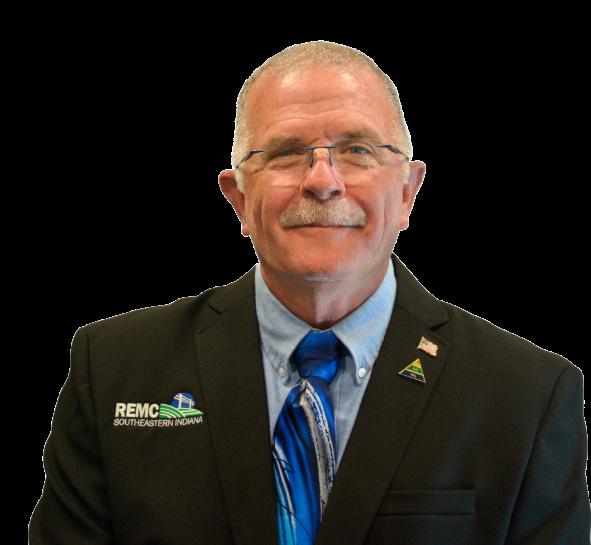
David Smith - District 3 Board Chairman at Hoosier Energy


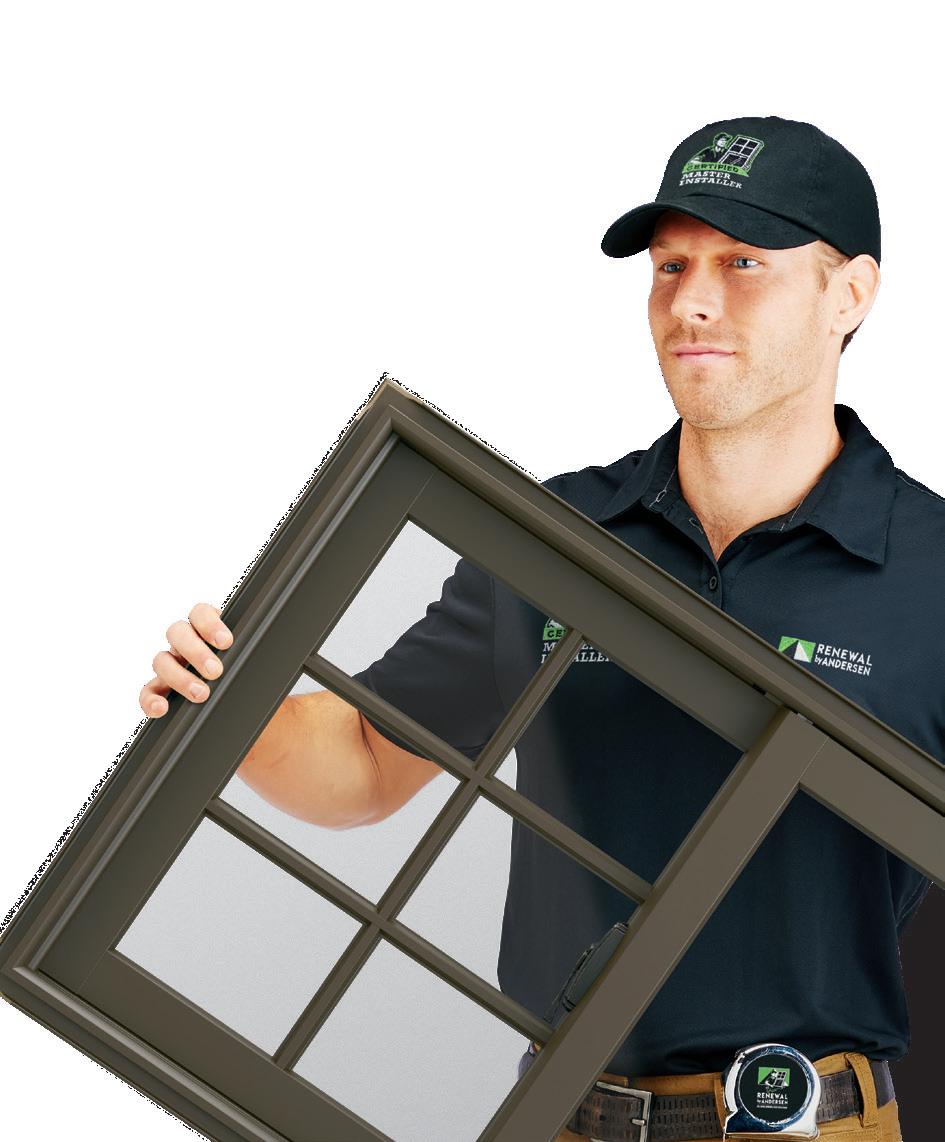
A dictionary definition of efficiency is performing a task using the least resources and producing the least waste.
Solar energy can certainly demonstrate efficiency by both measures. Consumers who use solar can realize long-term savings thanks to smaller utility bills and potential revenue from energy credits.
Solar energy efficiency has come a long way since the first photovoltaic (PV) solar cells were created in 1883. Back then, they converted only 1 to 2% of the total sunlight into usable energy.
Today’s PV solar cells have an average commercial energy conversion rate of 15 to 20%, and high-efficiency panels can reach as high as 23%.
Increasing the energy conversion rate is the only way to improve that efficiency further. However, scientists say the limit of what’s possible is 33%.
If you have solar energy or are thinking about installing it, what
else can make solar energy more efficient?
Eliminate shade
The first, and perhaps most obvious, way is to eliminate shade around solar panels. While direct sunlight is not necessary for solar panels to work, panels under shade do not produce a high enough output to be efficient. This is part of the reason deciding on an ideal location before installation is critical.
Face south
Another reason that location is important is to ensure optimal orientation for efficiency. Generally speaking, the ideal orientation is for solar panels to face south, ensuring maximum sunlight exposure throughout the day to get the highest output possible.
Keep them clean
After solar panels are installed, they need occasional cleaning. How often this occurs depends on the climate where the solar panels are located. They are particularly susceptible to natural dust accumulation, which can lead to as much as a 13% decline in output over three months.
Regularly assess the panels
Regular check-ups are key to maintaining efficiency. Quarterly preventive checks might help identify unusual output trends that could be hampering efficiency. This could be in conjunction with using energy management software to track the daily levels of generation.
Reduce reflection
Another helpful action is to invest in anti-reflection coatings for the solar panels. Sunlight can be lost through reflection, reducing what remains available to convert into energy.
Control power consumption
Managing power consumption can increase solar efficiency. Avoid running appliances like a dishwasher, microwave, and washing machine simultaneously, and turn off lights and fans when possible.
Add batteries
Finally, add solar batteries to enhance the system’s power to store unused energy during the day. Installing batteries close to solar panels will reduce any energy lost in transmission.
by Jennifer Scott







































Greene County is home to one of the largest wetland restoration sites in the United States — the Goose Pond Fish and Wildlife Area. Spanning more than 9,000 acres of restored prairie and marshland, the nature preserve attracts more than 12,000 visitors annually for birdwatching, fishing, and hunting.
Known as Indiana’s “most spectacular railroad bridge,” the Tulip Trestle stretches 2,295 feet across Greene County, connecting the towns of Solsberry and Tulip. Built in 1905 by Italian immigrants to transport coal, it was the longest rail trestle in the United States at the time and the third longest in the world. While passenger trains once traveled across the viaduct, that service was discontinued in 1948. Today, the Tulip Trestle remains in use as part of the Indiana Rail Road line that runs from Newton, Illinois, to Indianapolis.

Born in Linton in 1904, Phil Harris was an American entertainer best known for his role on “The Jack Benny Program” and for co-starring with his wife, actress and singer Alice Faye, on “The Phil Harris-Alice Faye Show.” Harris was also a voice actor in classic animated films, lending his voice to Baloo in “The Jungle Book,” Thomas O’Malley in “The Aristocats,” and Little John in “Robin Hood.” Before his death in 1995, Harris and Faye donated their show business memorabilia to the Linton Public Library, which now features a commemorative collection honoring his legacy.


Nearly 40,000 people visit Linton, Indiana, each year to celebrate the 4th of July during the city’s annual Linton Freedom Festival. This weeklong celebration at Humphrey Park includes a carnival, classic car show, flea market, golf tournament, 5K run, and more. The Linton Freedom Festival Parade, known as Indiana’s largest Independence Day parade, features festive floats and live music. Two 3- to 5-year-olds are crowned Miss Sparkler and Mr. Firecracker to represent their city in the parade.
FOUNDED: 1821
NAMED FOR: Nathaniel Greene, a military officer in the Revolutionary War
POPULATION: 30,803
COUNTY SEAT: Bloomfield
INDIANA COUNTY NUMBER: 28
Letters have been edited for length and clarity
I appreciated the article on Ernie Pyle in the recent Indiana Connection. We went to the museum in Dana several years ago. My husband and I have read “Ernie’s War,” which includes many of his columns. As the article commented, I felt that what he wrote about were not battles, but how the soldiers managed to live through the war. I understand why his columns were so important to the people back home. I also appreciated reading your own personal experience in learning about Ernie Pyle. He is someone to remember and honor.
My husband and I moved to Indiana from Chicago when we retired 15 years ago. We have been intentional about getting to know our adopted state and have noted some of the places mentioned in Indiana Connection for future trips. We are proud to be Hoosiers.
— Chris Schrey
I just wanted to let you know that I enjoyed reading the sobering article in the May issue of Indiana Connection magazine about the Guatemala mission trip of sorts that several REMC linemen made back in January and February.
I can’t stop thinking about the young girl the men met while working to install electricity for the first time in her remote village. She is 6 years old, the “head of the household,” and trying to care for younger siblings, mostly on her own. I cannot imagine it, and I am so touched to read about this extreme poverty and deprivation. And they are just now, in 2025, getting electricity for the first time. Incredible.
— Anne Keller
In the June issue, the measurements for a portion of the Blueberry Kuchen recipe on page 19 were incorrect. The correct measurements for the topping are: ¾ cup sugar, ½ cup all-purpose flour, and ¼ cup melted butter. We apologize for this error.
Our Marketplace offers maximum exposure for your business or organization at a minimal cost.
Please contact Cheryl Solomon, 847-749-4875 or cheryl@amp.coop , for other small business advertising opportunities in Indiana C onnection
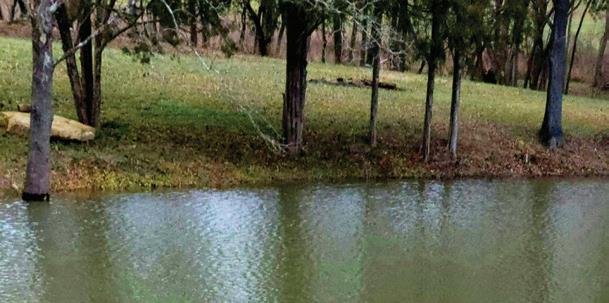






Bo-Mac’s Drive-In continues the tradition of great food and memorable moments in Shoals
owners in their own handwriting,” said Todd Baker.
These items include “Rox” burgers — two cheeseburgers stacked with hand-sliced, breaded onion rings and bacon — and “Coneys,” a take on the Coney Island hot dog smothered in a rich, meaty sauce.
The drive-in offers shakes, malts, cups, cones, sundaes, and flurries with what Baker calls “an endless variety of toppings.”
1960, an attorney and a doctor decided to dip their toes into the popular drive-in business. Bob and Mac created their drive-in restaurant near the intersection of Routes 50 and 150 in Shoals, Indiana, and named it after themselves.
Bo-Mac’s became an area institution. Its neon sign, still glowing today like a vintage beacon, has five words in all caps — SHAKES, SUNDAES, ROOT BEER, SANDWICHES — below its taunting swirl of ice cream sweeping skyward from a tilted sugar cone.
Current owners Todd and Blair Baker purchased it in 2021 from the Ragsdale family, who took it on a few years after it opened. They keep with the place’s tradition of sharing food and memories outdoors around picnic tables and in cars, which are still attended by carhops.
“Some of our main items that are really popular are from the original
Those “sandwiches” in the Bo-Mac’s sign? There are 17 different choices. Eight are burgers, including one “Firehouse Burger,” a cheeseburger topped with hot sauce, jalapenos, coney sauce, and coleslaw. The rest include catfish or cod and a variety of grilled or hand-breaded chicken options.
Most of Bo-Mac’s 18 side dishes, such as fries, fried mushrooms, and chicken strips, are dippable. Some have a twist like corn dog bites, nacho nuggets, and fried pickles, as well as potato salad, coleslaw, and baked beans.
In addition to a la carte for many of the above items, there are baskets, platters, buckets, and even barrels. Monthly, Bo-Mac’s offers an assortment of barbecued pork, which is smoked, grilled, or pulled.
Bo-Mac’s has an array of savory options, but many customers are beckoned by the swirl on the sign. “Ice cream is what we’re really known for,” Baker said.
A sampling can start with soft-serve chocolate or vanilla. Shake and malt territory can intersect with mint, cherry, pumpkin, pineapple, or blue raspberry. Floats can bob in Coca-Cola, root beer, red cream soda, or Dr. Pepper. Flurries can be mixed with ingredients like cheesecake bites and pina colada. The “Gold Brick” flurry has Heath bar, butterscotch, and nuts.
Bo-Mac’s is open from April to October and again from around Thanksgiving until February. Baker said one of his favorite parts of the business is what people share beneath the glowing sign, in addition to its food.
“I’ve been coming here for as long as I can remember, as it is with many locals, as well as their children and grandchildren,” he said. “First dates, birthdays, meaningful moments, it’s important to us to provide that space for customers and deliver a good experience and make more memories.”
Stephanie Bernaba is a freelancer with national reach who thrives on topics like food and entertainment.
















You may be planning a celebration this summer and looking to use fun decorations to help get everyone in the spirit. If you're thinking about using balloons outdoors, you should keep safety in mind.
Metal-coated balloons, or Mylars, can cause significant problems and pose a public safety risk. This kind of balloon is linked to thousands of power outages each year. But Indiana Electric Cooperatives wants you to know there are some ways to reduce the risk and safely use these balloons.
It’s helpful to know why these metal-coated balloons can cause issues. For starters, a gust of wind can grab the balloon — filled with
helium or not — break it loose from the string, and blow it into overhead power lines.
If this happens, the metallic coating can conduct electricity and cause a short circuit or power surge when in contact with the lines. This can lead to large-scale power outages, melting of electrical wires, and fires. Any of these can lead to possible injuries and property damage.
Helium-filled balloons that float away can drift for days and miles and come down anywhere. They are a risk to power lines and can also be dangerous to animals.
To reduce the risk of outages and injuries associated with Mylar balloons, remember to keep them away from power lines . In addition, make sure to tie helium-filled ones to a weight that’s heavy enough to prevent them from floating away.
Also, keep the weight attached until the balloons are deflated.
If you see a Mylar balloon in contact with a power line or in an electric substation, never attempt to retrieve it yourself . Keep yourself and all other items and people at least 20 feet away. Call the electric utility or 911.
When spending time outside this summer, stay far away from a downed or low-hanging power line. Always assume downed or lowhanging lines are electrified and dangerous. Call 911 immediately if you see a downed line.
Remember, balloons can be fun additions to your parties this summer. Just make sure you use caution and practice safety with Mylar balloons.
Chris Adam is a freelance writer from Lafayette.
Ensure
the first meeting between your new addition and your furry friend is a success
Your dog may own the spotlight now, but the arrival of a new baby requires adjustments, reassurance, and strategies to ensure a happy, safe interaction. Consider these tips whether you are preparing for a new child in your home or a new grandchild who will visit often.
Assess the norm

toy protective, or anxiousness from sudden movements. These aren’t deal-breakers, but they do provide opportunities to train and redirect behaviors.
the tone
Determine a baseline for your dog’s typical behavior, including whether it has previous experience with children. Look for potential challenges, like tugging, jumping, being overly food or
Familiarize your dog with what life with a baby might look like. If you’re welcoming the child, this will look different than welcoming a grandchild, niece, or nephew. Prepare your home with baby’s supplies early so your dog can get used to rearranged furniture and new off-limits playthings.

Practice your new routine, especially if your pet is your shadow. You may be prepared for sleepless nights, but your dog could become startled or agitated by hourly wakeups. Give them a mini boot camp to help them get used to regular disruptions. Avoid providing bathroom breaks unless they’re seniors, lest you create an unsustainable expectation.
Make sure your dog has its basic needs met, like food, water, exercise, and attention. Put the dog on its harness and leash and keep the baby secure before approaching slowly, pausing if the dog becomes overstimulated. Keep the first visit short, reward desired behavior, and repeat this routine to normalize the baby’s presence.
Monitor every visit between dog and baby and watch for stress signals, like pacing, yawning, and lipsmacking. If you see any of these, end the visit with a gentle redirection without punishment and try again another time.
Prioritize consistency and keep your dog’s usual routine going, maintaining walks and playtime to prevent jealousy and anxiety. Provide a safe, babyfree zone for your dog to relax in, especially as the baby grows and becomes more curious. Be consistent, teach gentle interactions, monitor visits, and work with a dog trainer if you need help.
Natalie Derrickson is a writer based in Indianapolis.
Charlotte Rymph, Monterey, Indiana
3 eggs, beaten
1½ cups sugar
½ cup butter, melted
2 tsp lemon juice
1 tsp vanilla
1 1⁄ 3 cups shredded coconut
½ cup coarsely broken pecans
1 unbaked 9-inch pie shell
Preheat oven to 350 F. Thoroughly whisk together the eggs, sugar, butter, lemon juice, and vanilla. Stir in the coconut and pecans, then pour into the pie shell. Bake for 45 to 50 minutes at 350 F or until filling is set. The pie can be garnished with whipped cream and pecan halves.

These grand champion desserts are sure to impress at any summer gathering

“With this recipe, I won first place in the Pillsbury Pie Baking Championship at the Indiana State Fair in 2013.”


Virginia L Bennett, Richardson, Texas
2 cups sugar
¾ cup butter
2 eggs
1 cup buttermilk, separated
3 cups flour, separated
1 tsp vanilla
1 rounded tsp baking soda
½ cup cocoa
1 cup boiling water
“This recipe was featured in the 1931 and 2001 Covington United Methodist Church cookbooks. When my niece was in 4-H in South Dakota, she entered it in the county contest, where it won the grand champion prize. This made it eligible for the South Dakota State Fair, where it also won grand champion.”
Combine the cocoa, baking soda, and boiling water. Stir well and set aside. Cream together the sugar and butter. Beat the eggs and add to the creamed mixture. Alternately add 1⁄ 3 cup of buttermilk and 1 cup of flour, mixing well after each addition. Add the vanilla and cocoa mixture, stirring until blended. Pour into two greased and floured 9-inch cake pans or 48 cupcake tins lined with paper inserts. Bake at 350 F for 30 to 40 minutes until a toothpick inserted in the center comes out clean. Cool the cake and frost with any icing of your choice.
2 Tbsp cocoa
2 cups powdered sugar
6 Tbsp softened butter
3 Tbsp whipping cream
½ tsp vanilla
Beat all ingredients together until light and fluffy. Makes 1 1⁄ 3 cups of frosting.
Donna Dettmer, Columbus, Indiana
1½ cups sugar
½ cup butter, softened but not melted
1 cup crushed pineapple, juice included
3 Tbsp flour
1 tsp vanilla
2 eggs
1 unbaked 9-inch pie shell
Beat together all the ingredients. Pour the mixture into an unbaked pie shell and bake for 50 minutes at 350 F or until it sets and the crust is brown.

“This pie was made by my daughter for a 4-H foods project and won a grand champion ribbon.”

Civic theaters are a vital cultural resource for communities throughout Indiana
BY JULIE YOUNG
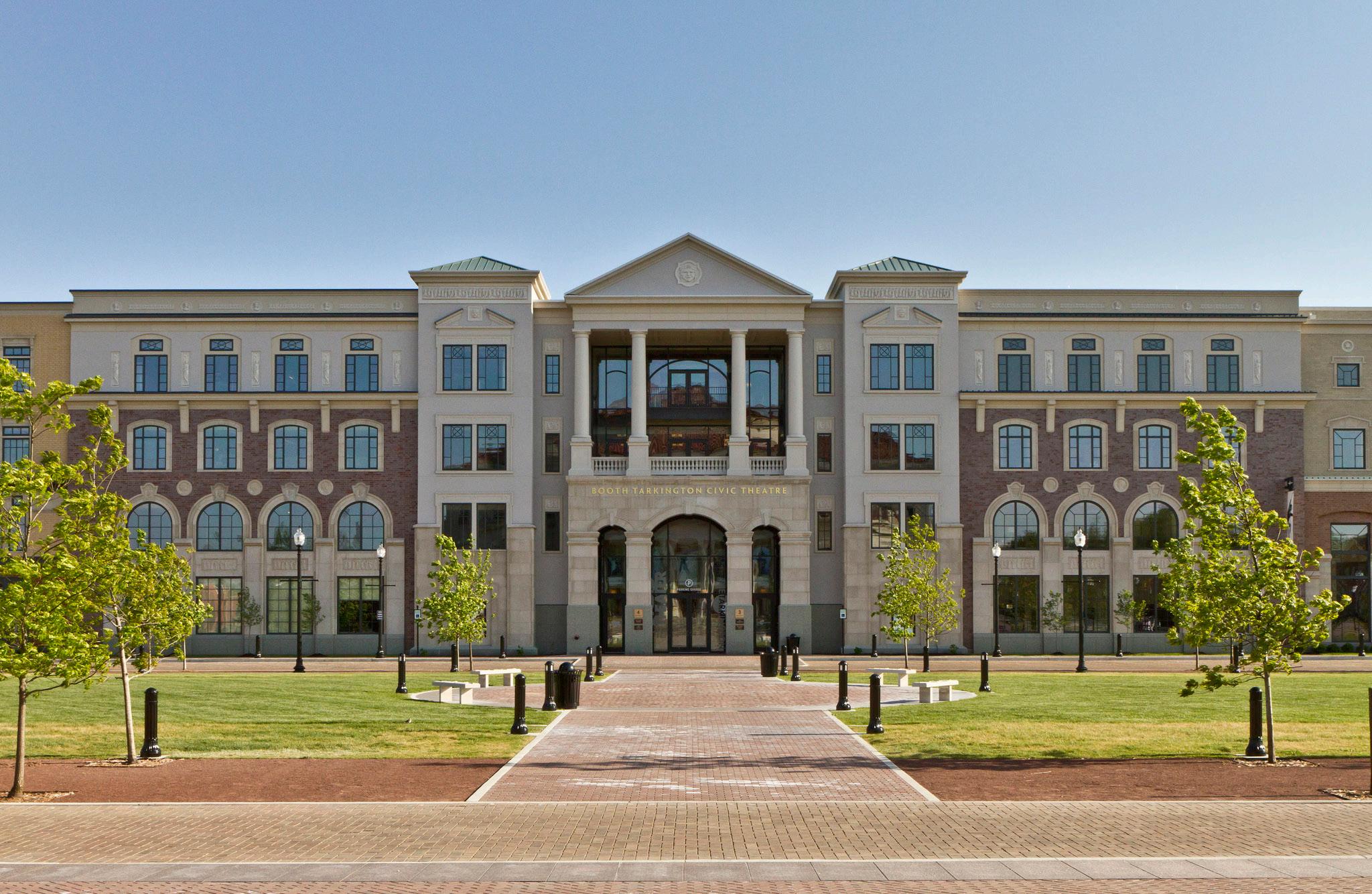
Civic theaters are companies of performing and non-performing players dedicated to providing accessible live theatrical events to the local community. Their productions take place in a variety of venues, and their seasonal offerings may include plays, musicals, youth productions, classic works, and emerging voices. Whether in a big city or a small town, civic theaters are a vibrant cultural resource that brings together people of all ages and backgrounds.
Luckily, Indiana is home to hundreds of civic theaters and other arts organizations that operate under the civic model. While some offer yearround professional performances, others might be seasonal labors of love for an all-volunteer cast and crew or geared for a niche audience.
“If you are looking for theater in Indiana, you are going to find it,” said Miah Michaelsen, executive director of the Indiana Arts Commission. “They are much more than the buildings
where performances are held…they are the connective tissue that keeps communities knitted together.”
Civic theaters grew out of the Little Theatre movement that operated throughout the United States in the early 20th century. These companies were organized by committed volunteers who staged experimental and royalty-free performances wherever they could find an available space. Through a combination of community support, local pride, and a desire to develop American playwrights, Little Theatres evolved into the civic theater model that exists today.
As the longest continually operating community theater in the United States, the Booth Tarkington Civic Theatre in Carmel has been part of the central Indiana landscape for over a century. Founded as the Little
Theatre Society of Indiana in 1914, the company installed itself in the sculpture court of the John Herron Art Institute. It opened a year later with a presentation of four plays, including “The Killing Triangle: A Domestic Melodrama”.
“The goal of the Little Theatre movement was to put new works on stage — a lot of which were melodramas,” said Michael Lasley, executive artistic director of the Booth Tarkington Civic Theatre. “In fact, if you look at a list of productions from the first 30 years, there is virtually nothing that is recognizable.”
When New Harmony native Frances Golden retired from the Vaudeville circuit and returned to southern Indiana in 1920, she brought along her considerable experience.
continued on page 22

continued from page 21
Having performed alongside her family members since she was a toddler and touring as a young adult throughout the U.S. and Europe, she was the perfect person to partner with the Evansville Recreation Commission to create the city’s first community theater company in 1925.
Originally known as the People’s Players and The Community Players, the Evansville Community Theatre opened in 1927 with a production of “Fashion, or Life in New York” by Anna Cora Mowatt. Golden served as the volunteer director of the theater from 1928 to 1941 while also training young singers at the local college (today, the University of Evansville) and operating her own conservatory, The Golden Studio of Voice. A true go-getter, Golden gave the Evansville theater community a sense of stability
and purpose that has shaped the company’s character for over 90 years.
Founded in 1947, Elkhart Civic Theatre traces its roots to the Elkhart Little Theaters, which provided high-quality productions of classic Shakespearean plays from a residential carriage house. The group performed throughout the late 1920s and into the 1930s, until World War II forced the company into an extended hiatus. Although its name changed after the relaunch, its objective remained the same.
“Elkhart Civic Theatre gives community members an artistic outlet and a way to make connections with others,” said Executive Director Dave DuFour. “For many, the social aspect is very important with lifelong
friendships resulting from working with others in the creative process.”
Cultivating an inclusive community through live theater is one thing, but finding a place to perform is another. After a decade of showcasing their talents in several all-purpose rooms and rented auditoriums, the Little Theatre Society of Indiana constructed a 240-seat playhouse in 1924. The facility was championed by noted author and playwright Booth Tarkington, whose works were often performed by Little Theatres, and he felt that they had an important role to play in the community.
The new playhouse opened in 1926 with a production of “Treasure Island,” and three years later, the company adopted a new name: Civic Theatre of Indianapolis. (Tarkington’s name would be added around 1949-1950 to honor the company’s early patron.)
Since its inception, the Booth Tarkington Civic Theatre has occupied five unique homes, including the Showalter Pavilion on the grounds of the Indianapolis Museum of Art and Marian University, before settling into The Tarkington, a 513-seat auditorium at the Allied Solutions Center for the Performing Arts just north of Indianapolis in Carmel. In this state-ofthe-art space, they continue to foster a love of theater through imagination, educational programming, and offering Broadway-caliber performances at community theater prices.
Lasley said that the last part isn’t easy. “Almost everything you see on the mainstage is the work of volunteer performers and crew members, but we are a professionally
In 1961, Elkhart Civic Theatre was able to lease, and ultimately purchase, the Bristol Theatre from the Moiser family, renaming it the Bristol Opera House.


managed company, which means we have a full-time staff. We also hire choreographers and musicians to help frame the performance you see on stage. It makes what we do expensive, comparatively speaking, but the end product you see is more polished.”
Although Frances Golden was alive to see the Evansville Community Theatre rebrand itself as the Evansville Civic Theatre in 1956, she did not live to see the organization secure the old
Columbia Theater as its permanent home after years of performing in various indoor and outdoor locations.
“Our building, which we acquired in 1974, holds a rich history, having previously served as a beer garden, burlesque club, and movie theater before coming under our ownership,” said Theatre Administrator Danielle Scott.
Built in 1910, the 222-seat space provided the organization with the perfect home for nearly 50 years. However, keeping up with a 115-yearold building does not come cheap.
continued on page 24

continued from page 23
When a 2020 fundraising effort fell short of its $150,000 goal, the Evansville Civic Theatre opted to say goodbye to the Fulton Street space and temporarily take up residence in Benjamin Bosse High School.
Scott said securing adequate funding is a challenge facing many theater communities today. “As an organization, we do all we can, and we are deeply grateful to those who contribute both their time and financial support…While many theater companies face the same challenges, each person associated with our theater strongly believes that through volunteering, whether behind-the-scenes or performing, we are helping to provide an artistic outlet and appreciation for the arts in our community.”
Like its counterparts, Elkhart Civic Theatre made its home in a variety
of locations, including the auditorium of the old downtown high school before moving into the former YWCA building (now known as the Lexington House). Although the YWCA had a stage, it proved to be inadequate for the company’s needs, and in 1961, Elkhart Civic Theatre was able to lease, and ultimately purchase, the Bristol Theatre from the Moiser family, renaming it the Bristol Opera House.
Built in two phases at the end of the 19th century by a local businessman, the original building housed the town’s post office, a basement barber shop, and a lodge meeting room on the second floor. The auditorium was added a few years later in hopes that the interurban railway system would grow and create a need for entertainment opportunities. Unfortunately, the railway failed, and aside from a few local events, the theater was rarely used.
After purchasing the building, Elkhart Civic Theatre opened up the archways
to connect the two spaces into one and made several other improvements so that it could serve their needs. Although the stage is quite small, it offers a larger backstage, wing, and downstage areas, allowing them to do more than they could at the YWCA. In 2018, the lobby was given a $110,000 renovation made possible by the generosity of theater patrons and a matching grant from the Elkhart Community Foundation. However, DuFour said there are always more needs than money, and fundraising is an ongoing process.
“Community theaters are affected by rising costs just as much as any other business,” he said. “At Elkhart Civic Theatre, utilities, insurance, lumber, fabric, and many other components have risen in price over the last couple of years, and theaters must cover those costs.”
Civic theaters are also challenged by the fact that audiences have so
many more sources of entertainment than they did during the Little Theatre days or even a few decades ago. Streaming services provide almost unlimited, cheap entertainment, so the challenge for any civic theater is to sell people on the value of seeing a live performance.
Michaelsen explains that, like other arts organizations, civic theaters are constantly competing for audience dollars and between materials, venue rentals, administrative costs, and more, it’s not getting any cheaper to put on a show.
“You are never going to be able to produce plays for less money than you would have five years ago, but that is the nature of live performance,” Michaelsen said. “Generally, ticket revenue only covers 40 to 50 percent of production costs, no matter if it is an
amateur or professional organization, so the rest of those dollars must be made up elsewhere.”
That usually means grants, donations, and sponsorships, but finding someone to write those grants, solicit those donations, and seek out those sponsorships is another challenge. It’s also harder to get the word out about the local theater company when so many communities no longer have local television or radio stations to help promote the mission.
“Trying to get the word out in a fragmented media environment is something we hear consistently,” she said. “You are pretty much at the whim of social media and the algorithm.”
So, how can audiences support their local civic theater organization? First, attend a performance. The people on that stage and behind the scenes
are your friends and neighbors, and every dollar you invest in a civic theater stays in the local market. In most cases, they volunteer their time and talent, so why not donate some of your time and money to support their hard work? Second, support those who support the arts. Typically, local businesses sponsor these productions, so consider being a customer of these businesses in your community. Third, participate! Whether you sing, act, dance, or have another skillset that can benefit your local theater organization, there is no time like the present to volunteer.
“Our doors are always open,” said Scott, “Whether you are interested in auditioning, volunteering, attending a performance, or participating in one of our community events. You are always welcome. No prior experience is required.”

• Rate schedule is based on your current age and is guaranteed for the
• Monthly rates as low as $3.49.
• Coverage is also available for your spouse and other family members.
• Benefits will NEVER be canceled or reduced for the life of the policy if premiums are paid on time. Policy Form #SRTCV/SRTCV R13 or R17, or #SRTCV90MA in MA
• Rates are based on your children’s or grandchildren’s present age and never increase for any reason.
• Monthly rates as low as $2.17.
• Benefits will NEVER be reduced or canceled if premiums are paid on time.
• Give your children a financial head start right now. Your policy builds CASH VALUE for your family’s needs. Policy Form #GWL2001 or GWLA001
Electric infrastructure (sometimes referred to as “the grid”) is the network that delivers electricity from power plants to homes and businesses. It consists of three primary components: generation, transmission, and distribution systems.
Transmission lines carry highvoltage electricity over long distances. They are supported by large towers and can span many miles and across states.
Once the transmission system carries the electricity to a substation, the voltage is reduced through transformers to a usable level for homes and most businesses.
This is where the distribution system begins.
Distribution lines carry lower-voltage electricity from substations to homes, schools, and businesses. These lines are most commonly supported by electric poles in the public rights-of-way, which form the core of the visible distribution network. Electric poles are strategically engineered and spaced
to maintain proper wire tension and safety clearances. They are equipped to withstand environmental conditions such as wind, rain, and some ice.
Distribution poles play a critical role in maintaining consistent and reliable power delivery. They typically carry three types of wires:
• Primary distribution lines: These lines carry electricity at medium voltage.
• Secondary lines: These further reduce voltage for household use.
• Neutral or ground wires: These help to ensure safety and system balance.
Poles may also support transformers, which step down the voltage to final usable levels. Electric distribution poles can also accommodate telecommunication and cable broadband lines, thus serving as the physical backbone of broadband deployment.
Understanding the basics of electric infrastructure — particularly the transmission and distribution system and its poles — highlights how vital and complex this network is in powering everyday life.
STEP 1
Generation
Electricity is generated from various sources
STEP 2
Step-Up
Transformer
Voltage is increased to push the electricty over long distances.
STEP 3
Transmission Power Lines
Lines carry electricity over long distances.
STEP 4
Transmission Substation
Voltage is lowered so electricity can travel across the local system.
STEP 5
Distribution
Substation
Voltage is lowered further for safe distribution.
STEP 6
Distribution Power Lines
Electricity travels across these lines in your community.
STEP 7
Final Stop
A transformer reduces voltage a final time, and electricity is sent to your home.
PRAISED for its amazing ability to heal the body, the ancient “nectar of the gods” may just be a 21st century healing miracle — the closest thing we have to a “cureall” for dozens of ailments from heart disease and heartburn to insomnia, low libido, fatigue, cough and cold, headaches, and more.
If you’re a weight-loss warrior, this gooey, golden syrup can even help flatten your belly and whittle your waist!
Surprisingly, 50% of Americans have this nourishing nectar in their kitchen cupboard. Chances are, you do, too, but you haven’t even begun to tap into its healing powers. More than a sweetener for tea and toast, this ancient superfood has been scientifically shown to help:


Inside your FREE BOOK you’ll discover 30 di erent healing varieties of honey — each with unique and remarkable “do your body good” powers. For example: Researchers at the Universiti Sains Malaysia reported dozens of studies found tualang honey can halt the growth of some cancer cells.
2 MILLION
Number of fl owers it takes for honeybees to make 1 pound of honey.
Then there’s the popular manuka honey, which can help you beat antibiotic-resistant MRSA and staph bacteria. Research shows manuka has a high antibacterial potency — great for treating skin infections and aiding digestion. But . . .


Prevent blood sugar swings


Stop Insomnia


Improve regularity
— no constipation


Heal cuts and scrapes


Ease asthma and allergies
1.31 POUNDS
SWEET FACT SWEET FACT




Ease tension


Send pain packing
There’s one little trick you must know before you use it. Make sure it’s medical-grade manuka honey. Find out how to tell if it’s the real deal in The Healing Powers of Honey.


Blast body fat






Relieve heartburn Fight wrinkles MUCH MORE!
Approximate amount of honey each person in the U.S. consumes every year.

Nature’s honey. Yes — the same honey that comes from a flower’s nectar consumed by the honeybee. In her book, The Healing Powers of Honey, bestselling author Cal Orey draws on interviews with doctors, researchers, and beekeepers to reveal the true power of this golden nectar.

And when you want to increase the number of healthy antioxidants in your body . . .
Try buckwheat honey. One study showed healthy men who drank water with buckwheat honey had a 7% boost in their antioxidant levels. This isn’t the only honey to power up antioxidant levels. Discover the two other varieties on page 74 of your copy. (Hurry, claim it today before all the FREE copies are gone!)




The Healing Powers of Honey doesn’t just give you the buzz on one, two, or three varieties of honey. Nope, it gives you the scoop on 30 di erent healing varieties so you know exactly which one, how much, and how to use it for what’s ailing you.
Wait until you see how much healing with honey is packed inside this breakthrough book . . .



Not all honey is the same . . .
Before you start plucking honey from your cupboard and adding it to your food or downing it by the spoonful, order your FREE COPY of The Healing Powers of Honey.















The Holland Energy Plant, located in central Illinois and co-owned by Hoosier Energy and Wabash Valley Power Alliance, has undergone the largest outage in its two-decade-old history this spring and summer.
Three major projects have been the focus at the natural gas facility: steam turbine inspection, gas turbine hot gas path inspection, and replacement of both Heat Recovery Steam Generator (HRSG) LP feed water heater tube bundles.
“The LP water heater is taking care of some longstanding issues we’ve had both with the reliability of that unit, as far as leaks, as well as some back pressure on the unit,” Holland Plant Manager Kent Schmohe said. “It’s been a three-year project in the making.”
Getting the tube bundle replacements to the plant was an undertaking, as
the journey began in Thailand. A ship carried them across the Pacific Ocean, through the Panama Canal, and to the Port of Houston, spanning 12,700 miles and 26 days. From there, the final 879 miles required special load semis pulling special trailers due to the size and weight of the bundles.
The rest of the work is no less crucial.
The steam turbine inspection must be done every 10 years.
“It’s really a report card on how we operate and how things are going as far as steam quality and how we operate the plant,” said Schmohe.
After opening the turbine and taking it to a shop in Milwaukee, the inspection found issues with the rotor and cracks in the leads. Resolving these issues took more time and money than expected, as Toshiba, the manufacturer, worked to get things back up to speed.

“We took care of those discoveries to make sure the unit is going to stay reliable for the next 10 years,” said Schmohe.
Last, but not least, the hot gas path on gas turbine No. 2 needs maintenance every five years.
“We use GE for that work,” Schmohe said. “There were very few discovery items, but we took care of those, so it should be ready to run for the summer and years to come.”
Over the past few years, Holland Energy Plant has been breaking records — achieving higher capacity, increasing operating time, and reducing restarts. This made the outage critically important.
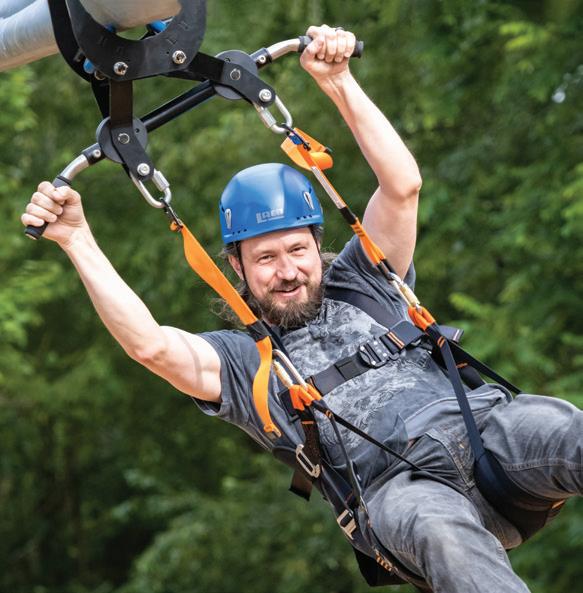
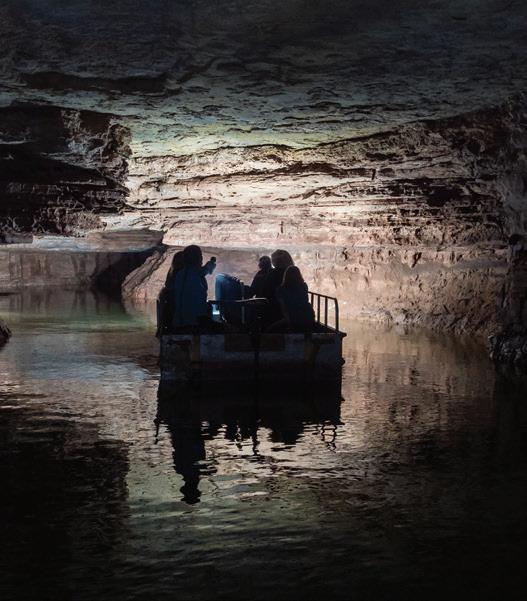

You might remember learning about caves and fossil formations years ago, but now is the time to add the magic of discovery back into your life. Indiana Caverns, located in Corydon, Indiana, welcomes visitors yearround, rain or shine, making it a perfect Midwest travel spot.
Home to one of the largest deposits of Ice Age bones, visitors can get an up-close view of fossilized remains, cave formations, and even a 40-foot waterfall. The 75-minute tour brings explorers of all ages 110 feet below civilization into the 56-degree caves, culminating at an underground river, an almost cinematic experience. The grated steel walkways guide tourgoers toward the river and onto a pontoon-style boat to gain deeper access to the cave and get closer to its formations.
If the cave tour has inspired you, discover more natural wonders by sifting through sand at the Peccary Mining Sluice. Great for all ages, explorers find treasures like fossils and gemstones while learning about their discoveries and how they came to be. The mine is open rain or shine and is a great option for all ages and those not quite ready for the cave tour. Plus, your mining spoils are yours to keep!
Take to the skies on the Bat Chaser — part zip-line, part roller coaster — and fly among the trees and over the sinkhole plain Indiana’s caves call home. Take off from the attraction’s 50-foot tower and travel 603 feet, twisting and turning through the groves with the best view in Southern Indiana.
For the most thrill-seeking types, there’s The Plunge, a 50-foot quick-drop experience that offers the exhilaration of bungee jumping with greater control. Using a controlled descent system, jumpers get the adrenaline fix without the recoil, landing on their feet, often ready for round two.
Natalie Derrickson is a writer based in Indianapolis.
Some Indiana gardeners get the mid-summer “blahs,” and our plants are no different. Summer annuals may look leggy with smaller flowers, and perennials may have too many seed heads. Flowering shrubs may be dotted with brown, dead flowers. All these “blahs” can be easily fixed. The benefits of deadheading
Annuals like cosmos and zinnia benefit from removing the spent flowers, called deadheading.
Perennials also benefit from this. Many annuals and perennials have a main stem and side shoots. Rather than just cut plants back, be selective. Look at the stem to see where the side shoots are. Remove the spent flower stem just above the side shoot. This allows the side shoots to develop new flowers and keep the plants blooming.
Petunia, verbena, sweet potato vine, coleus, and other annuals in pots can take a few snips to rein in their legginess and shape them. Use scissors, hand pruners, or your thumb and forefinger for the job. Then give the plant a shot of water-soluble fertilizer, according to label directions. If some annuals struggle with the heat, such as pansies, Diascia, or Gerber daisies, consider pulling them out and
replacing them with plants that can tolerate summer weather. Most garden centers still have plants ready for the job.
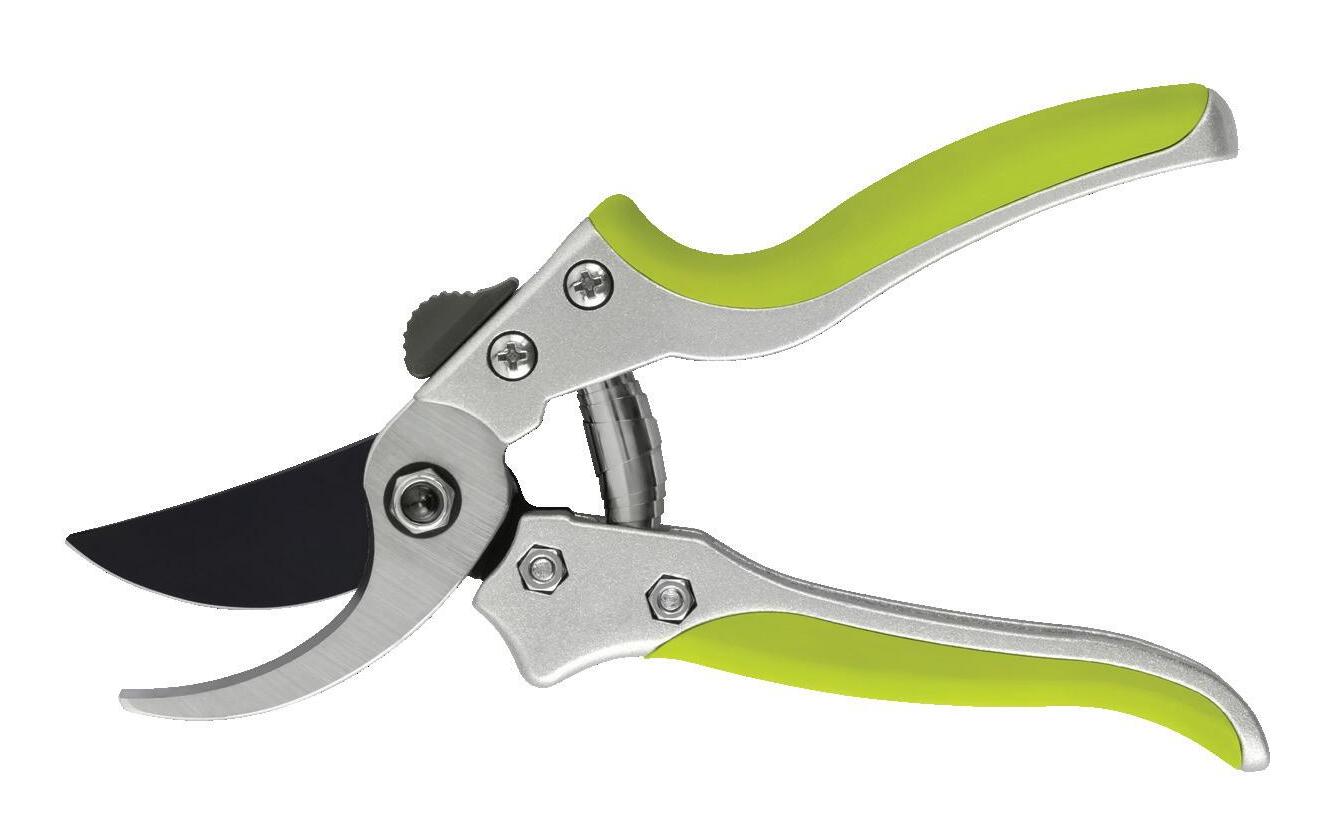
Deadhead spent or dead flowers from coneflowers, phlox, black-eyed Susans, salvias, and others. When the perennial is done blooming, cut it back to the base of the plant.
Other perennials, such as iris, may have a single stem. There are no side shoots, and the flowers bloom along the stem. In this case, cut them down to the base of the plant. In the case of irises, it’s likely done blooming for the season, and removing the stems tidies up the perennial.
Now is the time to remove the spent flowers on your springblooming shrubs. Many spring shrubs like lilacs, hydrangeas, and forsythias bloom on year-old wood. Next year’s flowers develop on stems beginning late summer.
For this task, remove just the spent flowers. You may notice that lower on the stem are side shoots, which will produce next year’s flowers. Like with perennials and annuals, remove the spent flower stem above the side shoots.
If the shrub needs to be pruned or shaped, be selective. Shrubs are usually meant to be tabletops or balls. For the lowest maintenance, allow shrubs to be themselves — upright, rounded, cascading, or fountain.
If you feed the birds, squirrels, and other critters, allow the seed heads to remain, especially as we transition to cooler weather. Wildlife appreciates the winter smorgasbord.
Jo Ellen Meyers Sharp blogs at hoosiergrdener.com


